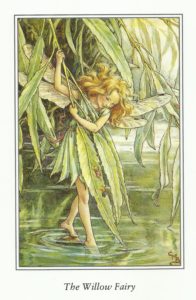Beavers have been called willow-farmers because by increasing the saturation of ponds and spreading the mud and water outwards they actually increase the amount of willow that can grow there and the mud-luscious conditions it loves to sprout in. Then after the new shoots get to sprout out they get to eat it and make more dams that spread the water farther and plant more willow. Pretty smart huh. So beavers make more willow.
And willow cures covid?
 Study shows willow bark extract has broad-spectrum antiviral effect
Study shows willow bark extract has broad-spectrum antiviral effect
 Scientists in Finland have now shown that an extract of willow bark—a plant that has already provided several medicines, including the precursor to modern aspirin—has a broad-spectrum antiviral effect in cell sample experiments.
Scientists in Finland have now shown that an extract of willow bark—a plant that has already provided several medicines, including the precursor to modern aspirin—has a broad-spectrum antiviral effect in cell sample experiments.
The extract worked both on enveloped coronaviruses, which cause colds as well as COVID-19, and non-enveloped enteroviruses, which cause infections such as flu and meningitis. There are no clinically approved drugs that work against enteroviruses directly, so this extract could be a future game-changer.
“We need broadly acting and efficient tools to combat the virus load in our everyday life,” said Prof Varpu Marjomäki of the University of Jyväskylä, senior author of the study in Frontiers in Microbiology. “Vaccinations are important, but they cannot deal with many of the newly emerging serotypes early enough to be effective on their own.”
I knew willow bark is what was used to make aspirin but this is pretty amazing. Beavers make willow and willow cures covid? Of course. That makes sense. Do they cure dementia too? Because they;re still a pest…
To make the extract, they harvested commercially grown willow branches. The bark was cut into pieces, frozen, ground, and then extracted using hot water. This produced the extract samples that the scientists tested against enteroviruses—strains of Coxsackievirus A and B—and coronaviruses—a seasonal coronavirus and COVID-19.
The scientists used a cytopathic effect inhibition assay to see how long the extract took to act on infected cells, and how well it inhibited viral activity. The extract did not harm the cells themselves and efficiently protected cells from infection. A binding assay carried out on the COVID-19 samples further showed that although this virus could enter cells even if treated with the extract, it couldn’t reproduce once it was inside.
Catching viruses out
The authors had previously found that the extract was effective against enteroviruses, which meant it could act against two differently-structured types of virus, enveloped and non-enveloped. However, the mechanism of action appeared to be very different, because treated enteroviruses couldn’t enter cells.
The scientists then experimented with the timing of addition of the extract to see if the extract attacked particular stages of the virus life cycle. They found that the extract seemed to act on the surface of the virus, rather than any given stage of its replication cycle.
They also examined the treated virus under the microscope to understand the effects of the extract better. Both viruses clustered together instead of spreading out, but the enveloped coronaviruses appeared to have been broken down, while the non-enveloped enteroviruses appeared to have been locked down, prevented from releasing their genome and reproducing.
“The extracts acted through distinct mechanisms against different viruses,” said Marjomäki. “But the extracts were equally effective in inhibiting the enveloped as well as non-enveloped viruses.”
You know I have been joking for a decade now that when science finds out beavers cure cancer they are still going to be officials saying that they should be trapped because they might cause flooding. This article just piles more fuel on the fire.
The authors also tested existing medical compounds derived from willow bark, as well as commercially prepared salixin extract and salixin powder. Of these, only the salixin extract showed antiviral activity, suggesting that the success of the scientists’ willow bark extract could result from the interactions of different bioactive compounds.
The scientists fractionated their extract to understand its chemical composition, but didn’t get clear answers as to which of the many effective compounds might be primarily responsible for the antiviral effect. Further research will be needed to understand the bioactive compounds involved, their chemical structure, and how they work, potentially leading to revolutionary new antiviral treatments.
More beavers are needed to fully understand the benefits they provide.






































